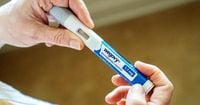WASHINGTON, D.C. — In a move that could reshape the landscape of obesity treatment in the United States, President Donald Trump announced a sweeping deal on November 6, 2025, with pharmaceutical giants Eli Lilly and Novo Nordisk. The agreement, unveiled from the Oval Office, promises to expand access and reduce prices for two of the country’s most sought-after obesity drugs—Zepbound and Wegovy—as well as upcoming pill versions that could further transform weight-loss therapy.
Obesity has long been a stubborn public health challenge in America, with over 100 million adults classified as obese, according to federal estimates cited by the Associated Press. The new deal, which Trump described as a “fat drug” initiative, takes direct aim at the cost and coverage barriers that have kept these promising medications out of reach for many. “(It) will save lives, improve the health of millions and millions of Americans,” Trump declared during the announcement, as reported by the Associated Press.
These drugs—GLP-1 receptor agonists—have made headlines for their ability to help patients shed between 15% and 22% of their body weight in clinical trials. That’s up to 50 pounds or more for some individuals. The medications work by targeting hormones in the gut and brain, suppressing appetite and increasing feelings of fullness. Yet, the typical price tag of around $500 a month for higher doses, combined with patchy insurance coverage, has made them unaffordable for many, especially those without robust health benefits.
The Trump administration’s new agreements aim to change that. Starting in 2026, Medicare will expand coverage for these drugs—not just for type 2 diabetes or cardiovascular disease, as is currently the case, but for obesity itself and related high-risk conditions. Eligible patients will pay just $50 copays for their medication, a dramatic drop from current out-of-pocket costs. The plan also covers state and federally funded Medicaid programs, targeting low-income Americans who have historically had scant access to such treatments.
But the changes don’t stop with government programs. Trump’s team has also launched the TrumpRx program, which will allow Americans to buy Zepbound and Wegovy directly from manufacturers, bypassing traditional insurance. According to administration officials cited by The New York Times, prices will start at around $350 a month in January 2026, with an expected decrease to $245 over the next two years. For those looking ahead to the new pill versions of these drugs, starting doses will be priced at $149 a month—contingent on FDA approval, which is expected to come soon for both Eli Lilly’s orforglipron and Novo Nordisk’s Wegovy pill.
“Trump is the friend of the forgotten American,” said Health and Human Services Secretary Robert F. Kennedy, Jr., during the White House event. “Obesity is a disease of poverty. And overwhelmingly, these drugs have only been available for people who have wealth.” While the Centers for Disease Control and Prevention data shows that obesity rates are actually slightly higher among middle-income Americans than among the poorest or wealthiest, the sentiment resonates with many who have struggled to afford these medications.
Still, the devil is in the details. As STAT News points out, the full policy underpinnings, economic implications, and public health outcomes of the deal remain to be clarified. While the administration touts the agreement as a win for consumers and the government, some experts and industry leaders are waiting to see whether the bold promises translate into real-world savings and expanded access for the millions who need these drugs.
For now, the price reductions are substantial—at least on paper. Lilly has committed to selling a starter dose of Zepbound for $299 a month and higher doses up to $449, both $50 less than current direct-to-patient prices. Novo Nordisk, meanwhile, has agreed to offer similar discounts, though the company has declined to provide specific figures. The government’s bulk purchasing power, combined with direct-to-consumer sales, is expected to drive down prices further over time, according to administration officials.
But even with these lower prices, the question of affordability lingers. Dr. Leslie Golden, an obesity medicine specialist in Watertown, Wisconsin, told the Associated Press that about 75% of her 600 patients on these treatments struggle to pay for them—even with insurance. Some patients face copayments as high as $150 per refill, leading to tough decisions about whether to continue treatment. “Every visit it’s, ‘How long can we continue to do this? What’s the plan if I can’t continue?’” Golden said. “Some of them are working additional jobs or delaying retirement so they can continue to pay for it.”
The stakes are high not just for patients, but for the pharmaceutical companies as well. Lilly reported that sales of Zepbound have already tripled this year, soaring past $9 billion. The popularity of GLP-1 drugs has fueled a rush of innovation, with both Lilly and Novo Nordisk racing to bring pill versions to market. On the same day as Trump’s announcement, the Food and Drug Administration agreed to expedite review of Lilly’s orforglipron, while a decision on the Wegovy pill is expected later this year.
Despite the promise of expanded access, the new deal won’t cover every American with obesity. As The New York Times notes, the measures are likely to stop far short of universal coverage under federal programs. Many commercial insurers and employers remain wary of the costs associated with covering these drugs for large populations, given the high prevalence of obesity in the U.S.
The timing of the announcement is also notable. Just days earlier, Democrats swept elections in key races across the country, with economic worries dominating voters’ minds, according to AP voter polls. The Trump administration’s move is widely seen as an attempt to show responsiveness to Americans’ cost-of-living concerns, particularly as prices for food, housing, and health care continue to climb.
In the political arena, the deal has sparked both praise and skepticism. The White House has sought to distinguish its approach from the previous Democratic administration, which had proposed a rule to expand Medicare coverage for weight-loss drugs but was criticized by Trump’s team as too generous to the pharmaceutical industry. Instead, Trump’s officials claim their deal ensures Americans aren’t unfairly subsidizing drug innovation for the rest of the world.
For now, millions of Americans living with obesity—and the doctors who treat them—are watching closely. If the administration’s promises bear out, the coming year could mark a turning point in the fight against one of the nation’s most persistent health challenges. But as with any ambitious policy shift, the real test will be in the implementation—and whether those who need these drugs most will finally be able to afford them.
With regulatory decisions on new pill versions looming and price reductions set to roll out in the coming months, the story of America’s battle with obesity drugs is far from over. But for many, hope is on the horizon.




